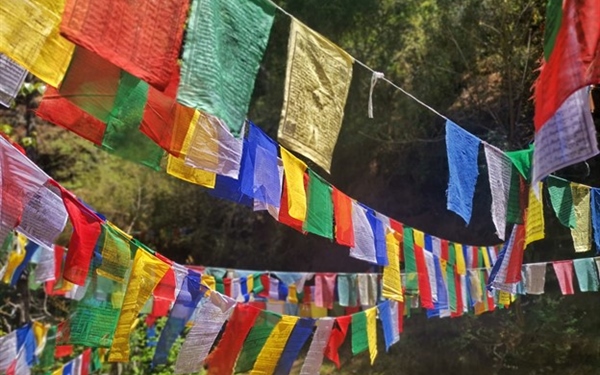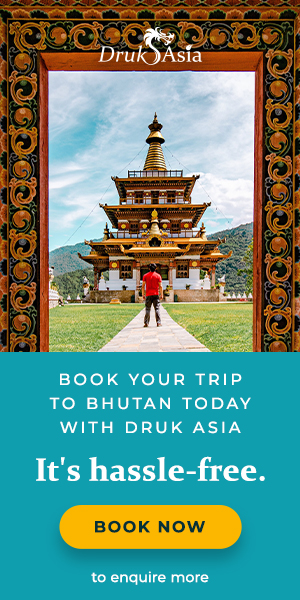Prayer Flags Outnumbers Stray Dogs in Bhutan
The most beautiful pictures of the capital city of Bhutan is seen from the Sangaygang Viewpoint where there are villages of clustered fluttering prayer flags. Hung high in order to catch the wind, prayer flags are placed there because they are believed to bring good luck, happiness, long life and to offer good karma to all sentient beings.

As a Buddhist nation, Buddhism is very much imbibed in the lives of Bhutanese people. The first thing they do in the morning before having a cup of hot butter tea (suja) is going to the altar and offer their prayers for the well being of all sentient beings in the world.
According to the Great Buddhist Saint Guru Padmasambhava, Bhutan is noted as the most sacred and sanctified paradise in the universe. Thus if Buddhists make an effort to chant or say prayers in some of the most venerated monastery’s and pilgrim sites, the prayers and wishes are believed to come true. Therefore local people travel far and beyond to pay homage to the deities of the locality.
Today, tourists also travel to Bhutan in search of their religious pursue. If the guests are interested to learn deeply about Buddhism tour companies offer rituals such as teachings and blessings by respected and revered saints, the changing and hosting annually of the village prayer flags for the prosperity and well-being of the community, the consecration of buildings and community prayers and fasting ceremonies.
Tourists travelling to Bhutan are often seen hanging prayer flags on the hilltop, along the bridges etc. because it is believed that the deed will bring good luck, happiness, long life and offer good karma to all sentient beings.
There is a common misconception that the flags carry mantras to the gods rather, the mantras printed on the flags are carried on the wind and believed to spread goodwill and positive energy wherever they go.
Bhutan Prayer Flags Color Meaning
Prayer flags are bright and beautiful, but their colours aren't just for show. Each hue signifies an element. There are several types of prayer flags in Bhutan. Lungdhar is square or rectangular in shape, made of the five colours, are connected along their top edges, and hung horizontally or diagonally on a string. In the centre of each flag a prevalent symbol is printed, the Wind Horse (Lungta), which is a horse that carries on its back the wish-fulfilling jewel of enlightenment.
Darchor, also made of the five colours, are very tall vertical flags attached to poles planted in the ground. Darchor translates as “to increase life, fortune, health and wealth for all sentient beings.”
Lhadhar, the largest flag, is also very tall vertical flags. They are white in colour, usually have no text, and contain ribbons of red, yellow, and blue. Lhadhar is displayed in front of important places, such as monasteries and palaces, and one must be formally dressed to enter these places. Lhadhar represents victory over the forces of evil and are commonly inscribed with the four powerful animals, the tiger, the snow lion, the dragon, and the Garuda (a celestial royal bird). These animals are also on the four outside corners of a Lungdhar prayer flag, surrounding and guarding the Wind Horse.
Goendhar, the smallest prayer flag, is located in the middle of a rooftop of a home. Rectangular in shape, they are white with ribbons of green, red, yellow, and blue attached to the edges. These flags are blessings for welfare, prosperity, and harmony in the family.
Very tall white prayer flags, Manidhar, are also vertical and attached to poles. They are raised on behalf of a deceased person, as a way of remembering the person who died. It is believed that there are benefits from hoisting batches of 108 (an auspicious number) of Manidhar prayer flags. Although, hoisting one flag is just as beneficial.
Significance
The white prayer flag is for good fortune by purifying negative karma
The blue prayer flag is for health and longevity.
The yellow prayer flag is for victory over obstacles.
The red prayer flag is for fulfilling your wishes.
The green prayer flag is for compassion.
You don't have to be a Buddhist to hang prayer flags, but there is a right way to hang them. While stringing your flags up wherever you choose to display them, it's important to keep good, selfless motivations in mind, in keeping with the flags' ultimate purpose, which is spreading positivity far and wide.




